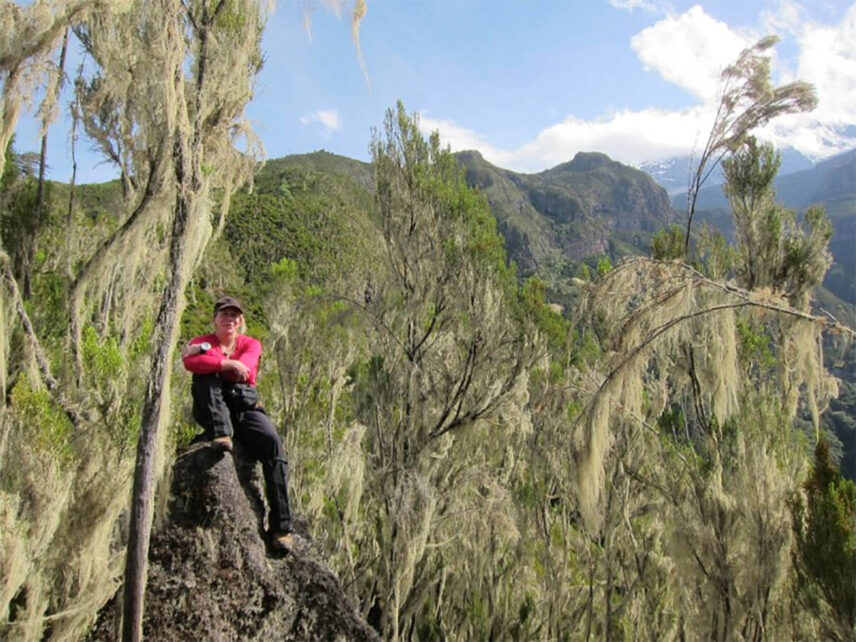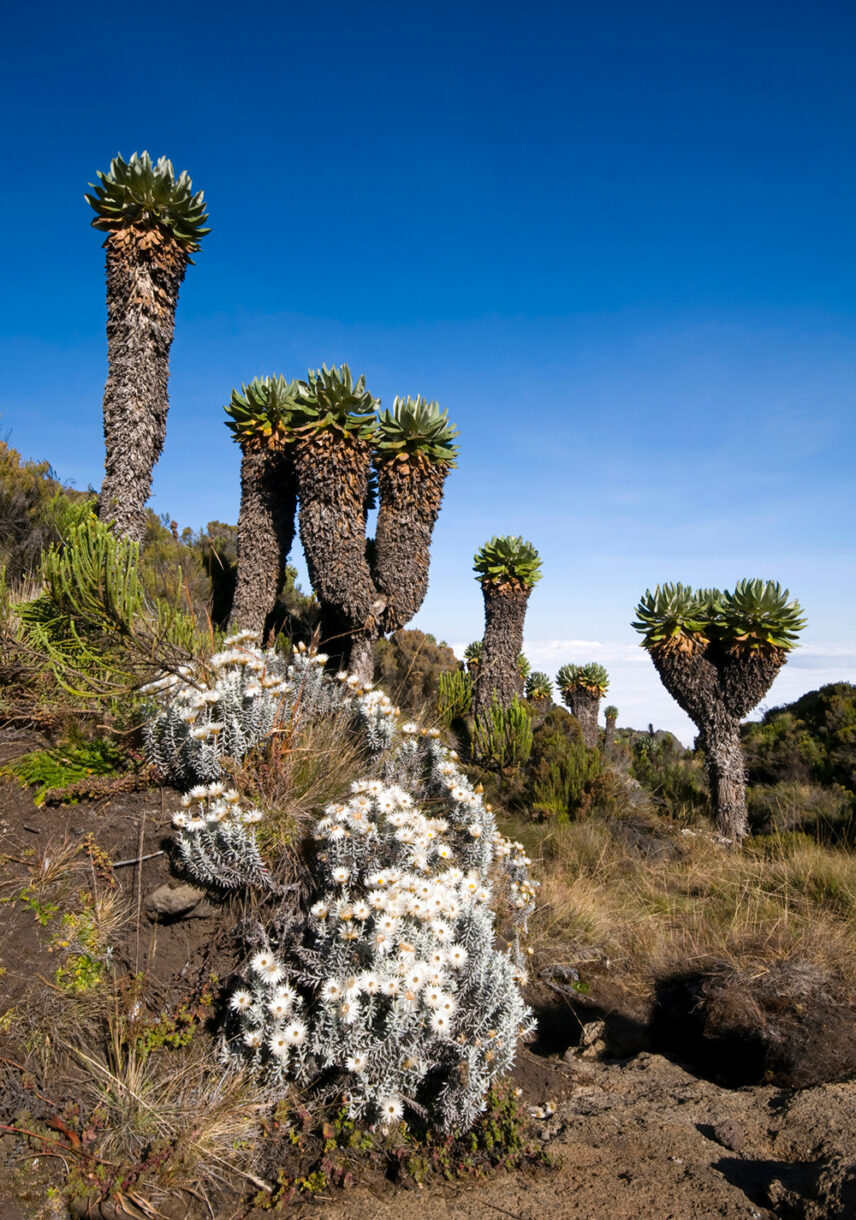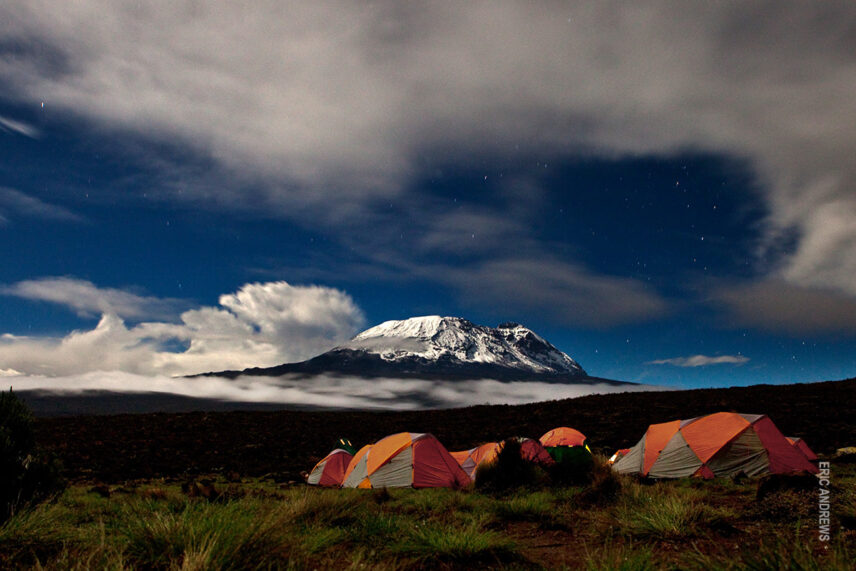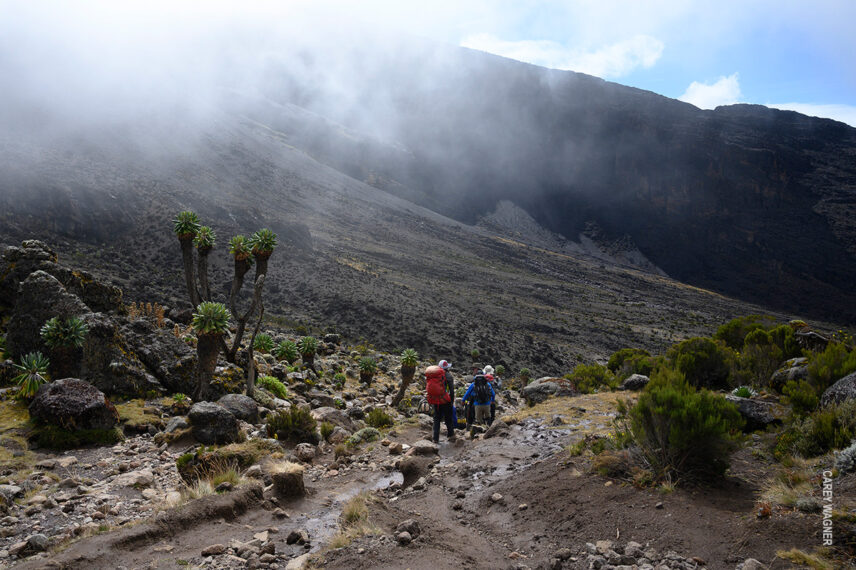Once you’ve left the lush canopy of Kilimanjaro’s tropical rainforest – up ahead lie miles of meadows carpeted with scrub and everlasting wildflowers. There are trickling streams banked by green peat moss.
Through the morning mist, you can see candelabra-shaped groundsels with gnarled branches thrust up from the earth.
Welcome to Mount Kilimanjaro’s Heath and Moorland zones.

Trekker in thick heather vegetation
You’ll trek through 5 climate zones as you make your way to Kilimanjaro’s summit. While similar in many ways, the heath and moorland each feature unique characteristics and natural beauty. Here is what makes these areas so special!
Fast Facts: Heath & Moorland
Heath elevation: 9,200′-11,000′
Moorland elevation: 11,000′-13,200′
Day temps: 50s-70s °F
Night temps: 30s-50s °F
Annual precipitation: 21-50″
Characteristics of Kilimanjaro’s Heath and Moorland
The heath is far more temperate than the rainforest, with open land and poor soil that can only support shrubs, such as heather and other low-growing, woody vegetation. This area generally receives less rainfall, making it quite arid.
The moorland receives a bit more rainfall than the heath and retains moisture in the soil better, supporting a mix of grasses, mosses and shrubs. Dominating the moorland is the giant groundsel, a “mutant weed” that can stand between 4-16′ tall!

Giant groundsels and everlastings are common in the Moorland zone
Both climate zones can support only a sparse distribution of plant life. Both the heath and moor are hardy and drought-resistant, with cooler climates and generally lower moisture levels. While you may spot some wildlife in the rainforest, the heath/moorland zones are stingy environments, likely yielding only a rodent or two during your crossing.
Where Will You Camp in the Heath and Moorland During Your Kili Trek?

Shira Camp at night
Most Thomson trekkers will spend one day trekking in the heath, and one in the moorland. For example, on Thomson’s Western Approach Route, you’ll sleep at Shira 1 Camp on day two, with stunning, sweeping views of the mountain far in front of you. Shira 2 Camp will be your home away from home on day three, located higher on the Shira Plateau, with a rockier, more arid landscape.
What’s It Like to Trek through the Heath and Moorland?
To trek the heath and moorland zones is to trek through a landscape sculpted by wind. Meadows carry the faint scent of wildflowers and earth, and the air grows cool, crisp and thin.

The terrain is relatively stable, with well-trodden paths winding through volcanic soil, scree, rocky outcrops, and occasional streams. While not technical, the heath and moorland zones can be uneven and require careful footing. Mist and fog often roll in during the mornings and evenings, creating a moody, ethereal atmosphere.
Your main challenge here will be the altitude. Familiarizing yourself with the common symptoms can help you prepare for the effects, and opting for a longer trek will allow your body to better acclimatize.

Overall, the heath and moorlands are places of striking contrasts and unspoiled beauty. It’s the first true test for many Kilimanjaro trekkers, as they learn to combat altitude and uneven terrain.
Expect strong winds and potentially rapid shifts in weather. Sunshine can turn to hail or rain quickly.
Tips for Tackling the Heath and Moorland
1. Prepare for the Sun.
The shade of the forest is gone—the sun will be on your back from here to the summit. Make sure you apply sunscreen to all exposed skin including your lips, wear sunglasses and wear a hat to protect against sunburn.
2. Pole Pole.
You’ll hear your guides say this phrase (which translates to “slowly”) countless times on the mountain. The heath and moorland zones are where you can set yourself up for summit success by acclimatizing. This is the area where most trekkers begin to feel the effects of altitude and going slowly is the best way to let your body adjust. Make sure your guide knows when you’re struggling and always follow their guidelines for combating altitude sickness, such as drinking plenty of water and eating a lot at each meal to keep your strength up.
3. Block the Wind.
The open, arid plains of the heath/moorland have virtually no natural shelter against blustering, chilly winds. Prepare with a hard-shell jacket to keep out the cold.
4. Protect Your Feet.
In addition to a comfortable pair of hiking boots, you’ll want to make sure you have a pair of gaiters for your climb. These will be especially useful to protect your feet and lower legs in the heath/moorlands from shrubs, rocks, mud, and streams.
5. Take in the View.
With the forest canopy out of the way, you can see all the way to the summit. It’s an inspiring view of the peak you’re striving for and can help keep you motivated for the challenges that await!
Climbing Kilimanjaro is like trekking from the equator to the North Pole, as the mountain encompasses five distinct climate zones.
